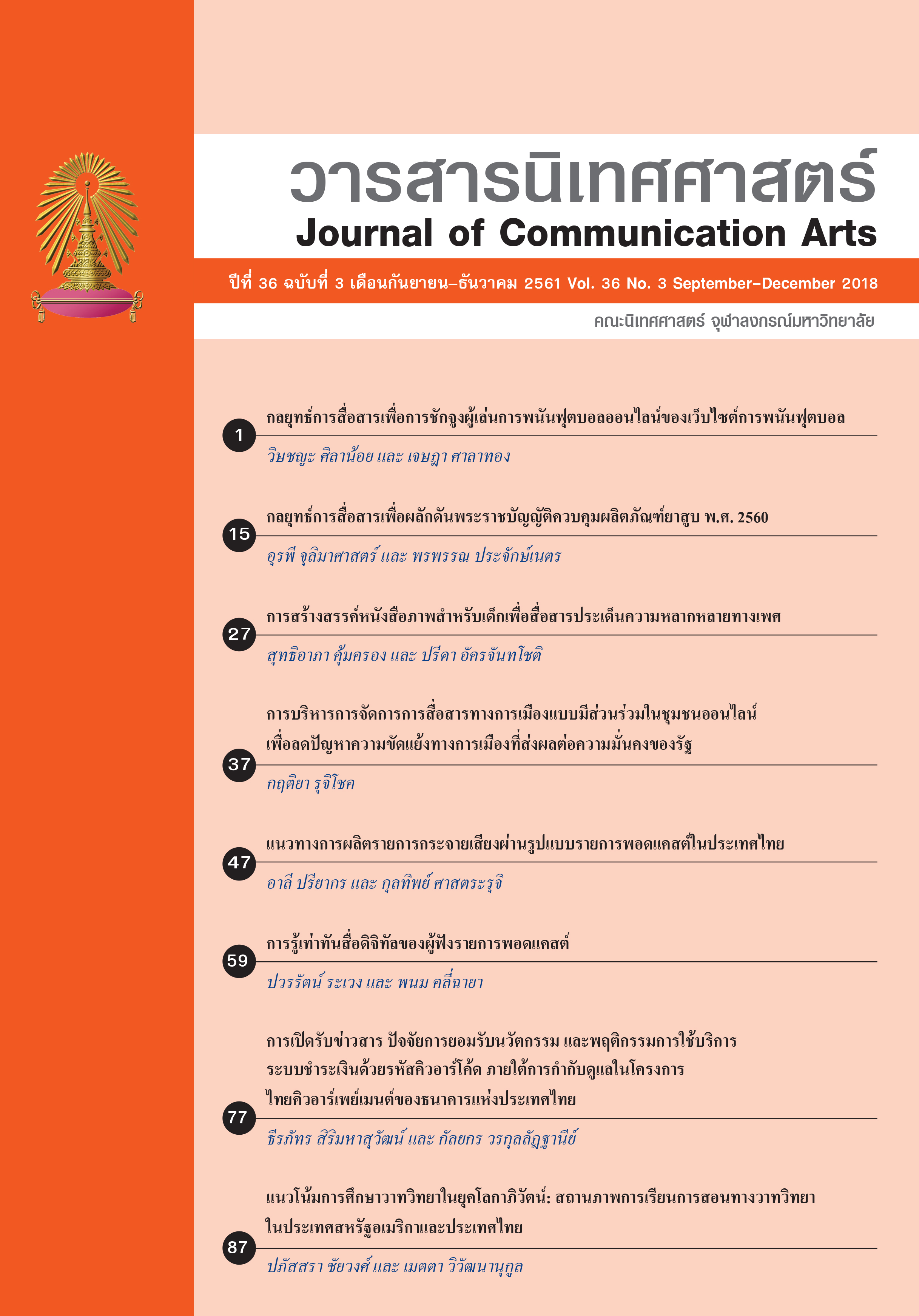Creation of Children’s Picture Book for Communication on Gender Diversity
Main Article Content
Abstract
This research is a study about communication on gender diversity depicted in children's picture books. The objectives of this study are to analyze the attributes of children's picture books that are made for gender diversity communication, to study the process of creating a children's picture book with communication on gender diversity in Thai's society context and to study the recipients’ understanding of gender diversity after reading children's picture book made to communicate gender diversity in Thai's society.
It was found that an important attribute of children's picture books for communicating gender diversity is to include the topic in a basic and familiar manner as any other children's picture books are depicted by using semiotics, and/or attenuation to reflect the person’s self-value, promote freedom of will and acceptance in oneself.
Thus "Chud Mai KhongLukMhee" (Little bear's new dresses); a children’s picture book for communicating gender diversity in Thai’s society context was created based on those attributes above. The making of this book consists of five steps inserted with concept of gender diversity in symbolic form among various elements of the book such as the fabrication of the character, clothing and context described with the purpose of promoting freedom of will and acceptance in oneself.
The result showed that recipients can understand the message of free will from the "Chud Mai KhongLukMhee" picture book but need additional explanations at the end of the book for better understanding. Also the most understood symbolic depiction are "skirt" and "pants". And because all recipients have some backgrounds on recognizing gender diversity issues, most could get the message about promoting self-value and acceptance in oneself. Still there are some people who refuse to choose "Chud Mai KhongLukMhee" as a picture book for their children for the reason that it’s unnecessary.
Article Details
References
กนิษฐา สุขสมัย และพิทักษ์ ศิริวงศ์. (2559). เรื่องเล่าหญิงรักหญิง: วิถีเพศของคู่รักสูงวัย. วารสารสังคมศาสตร์ มหาวิทยาลัยศิลปากร, 5(2), 123-134. http://journal.rmutto.ac.th/template/design/file_article
/article.368pdf.
จิราภรณ์ อรุณากูร. กุมารแพทย์เวชศาสตร์วัยรุ่น ภาควิชากุมารเวชศาสตร์ คณะแพทยศาสตร์ โรงพยาบาลรามาธิบดี. (21 พฤศจิกายน 2560). สัมภาษณ์.
เจด็จ คชฤทธิ์. (2554). เด็กกับหนังสือ : คู่มือเพื่อความเข้าใจเด็กและหนังสือสำหรับเด็ก. พิมพ์ครั้งที่ 1. นนทบุรี: บ้านหนังสือ.
ทัศนีย์ คำเกิงศักดิ์. (2554). การวิเคราะห์เนื้อหาเพศศึกษาและความพึงพอใจของผู้รับสารที่มีต่อคอลัมน์ "เสพสมบ่มิสม" และเว็บไซต์ meetdoctor.com. วารสารนิเทศศาสตร์, 29(1), 94-106
นฤพนธ์ ด้วงวิเศษ. (2556). "ลูกผสม" ของวัฒนธรรมทางเพศในสังคมไทย. ใน นฤพนธ์ ด้วงวิเศษ และปีเตอร์ เอ. แจ็คสัน (บรรณาธิการ), เพศ หลากเฉดสี : พหุวัฒนธรรมทางเพศในสังคมไทย. (น. 29- 53). พิมพ์ครั้งที่ 1. กรุงเทพฯ: ศูนย์มานุษยวิทยาสิรินธร.
นฤพนธ์ ด้วงวิเศษ. (2559). แนวคิดทฤษฎีเรื่อง "ความหลากหลายทางเพศ". วันที่เข้าถึงข้อมูล 15 กุมภาพันธ์ 2560, แหล่งที่มา www.sac.or.th/th/wp-content/uploads/2016/05/Sexual-diversity.pdf.
ปภาภรณ์ ไชยหาญชาญชัย. (2559). การรับรู้ถึงความใกล้ชิดกับพ่อแม่และการเปิดเผยตนเองของลูกในวัยรุ่น. วารสารนิเทศศาสตร์, 34(2), 107-120
รพินทร คงสมบูรณ์. อาจารย์ประจำสาขาวรรณกรรมสำหรับเด็ก มหาวิทยาลัยศรีนครินทรวิโรฒ. (22 พฤศจิกายน2560). สัมภาษณ์.
วุฒิพงศ์ ถายะพิงค์ อาจารย์, วิทยากร, นักเขียน และนักส่งเสริมสุขภาพจิต. (28 พฤศจิกายน 2560). สัมภาษณ์.
สังคมไทยคิดอย่างไรกับเพศที่ 3. (2560). วันที่เข้าถึงข้อมูล 20 กุมภาพันธ์ 2560, แหล่งที่มา http://nidapoll.
nida.ac.th/index.php?op=polls-detail&id=317.
สังคมไทยเปิดใจรับเพศที่สาม เหตุสื่อเป็นตัวแปรสำคัญ. (2559). วารสารดิจิตอล มหาวิทยาลัยรังสิต. วันที่เข้าถึงข้อมูล 22 กุมภาพันธ์ 2560, แหล่งที่มา http://www.jr-rsu.net/article/2256.

